Capturing wind for cooling, using wood and clay as basic materials for houses, or constructing buildings tuned to the sun’s daily path to provide natural shade: Instead of overexploiting nature, a new generation of architects in sub-Saharan Africa is focusing on building practices that conserve resources and are climate-friendly.
“It is high time,” says Francis Kere, one of the best known sub-Saharan architects who was born in Burkina Faso and now lives in Berlin. “For a better future for all of us, not just in Africa, but for all of us on this planet, it’s important to go back and actually use only those materials that nature gives us freely and to stop overexploiting them,” he told DW.
Kere is designing the new Goethe-Institut in Dakar. This is the first time in the history of the German cultural institute that a building commissioned specifically for their purposes is being built in sub-Saharan Africa. “We are very pleased that Francis Kere has taken on the design of this building,” said Philip Küppers, director of the Dakar Goethe-Institut, adding it was always clear “it had to be an interaction between Germans and Senegalese or West Africans.” On February 21, German President Frank-Walter Steinmeier will attend the ceremonial laying of the foundation stone.
Traditional building materials
For the construction, Kere will use local building materials including clay and laterite, a highly compacted soil that can be cut into brick-shaped blocks. The building’s walls will be made of a double layer of BTC bricks (French acronym for briques de terre compressée), pressed from slightly moistened soil with the addition of a little cement, making them strong and waterproof.

Innovative school design in Gando, Burkina Faso
In addition, the architect plans on using clay, which has been used in the Sahel region for centuries due to its temperature-regulating properties. Kere’s approach is both traditional and contemporary. He also plans to employ local workers, for the most part. “Building is a big job and that requires many, many people working together, but also people who have a lot of experience and pass their knowledge to the next generation,” the architect explains. It’s a community event that has worked well for the architect in previous projects, he says.
Despite his international success, Francis Kere has never forgotten his roots. He grew up in a small village in rural Burkina Faso. To attend elementary school, he moved to the nearest town where he lived with relatives for a while. In the 1980s, a scholarship brought him to Berlin, where he initially trained as a carpenter before beginning architecture studies at the Technical University. While still a student, he completed his first major construction project in his native country, building an elementary school in the village of Gando.
In 2004, he received the Agha Khan Award for Architecture, the first of several awards. He almost didn’t return to university, but his professors convinced him to complete his studies. In 2005, he founded his own firm in Berlin, Kere Architecture. He has been very successful internationally, known among other things for Opera Village Africa, an arts education project in the capital of Burkina Faso that was initiated by the late German film director, Christoph Schlingensief.
The new Goethe-Institut in Dakar will be able to accomodate about 600 students, with space for video conferences and online courses, according to Philip Küppers. A recording studio will be installed in the library for digital recordings of the local population’s oral histories. Küppers sees the role of the institute, which has been in Dakar since 1978, as primarily fostering dialog among people and strengthening mutual understanding.
Symbolism of the baobab tree
The large baobab tree around which the building is being constructed is highly symbolic for the Senegalese, Küppers points out. “It’s the place where people would come together in the village, where the elders gathered, where issues were discussed, where maybe the small local court would adjudicate a dispute,” Küppers said. It’s a place of discourse and gathering, which is exactly what a Goethe-Institut does, “bring people together to discuss things, to develop something new.” The start of construction was delayed due to the COVID pandemic, but the new institute is now expected to open its doors in the summer of 2023.
This article was originally written in German.
Francis Kere designs new Goethe-Institut in Senegal
Source: Pinoy Pop News

0 Comments